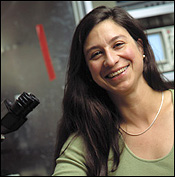In this column, I ask neuroscience professors from around the world the same five questions. Read on to learn more about their research, careers and goals for neuroscience in the future.

Interview with Professor Gina G Turrigiano
Gina Turrigiano holds the Joseph Levitan Chair in the Dept. of Biology at Brandeis. She has received numerous awards for her research including a MacArthur foundation “genius” award, McKnight Foundation Technological Innovation and Neurobiology of Disease awards, an NIH director’s pioneer award, and the HFSP Nakasone Award. she is a fellow of the American Academy of Arts and Sciences, a Fellow of the American Association for the Advancement of Science, and a member of the National Academy of Sciences. Her scientific interests include mechanisms of synaptic and intrinsic plasticity and the experience-dependent rewiring of neocortical microcircuitry.
1. What inspired you to pursue neuroscience as a career?
I was a “free range” kid, and spent most of my time growing up outdoors exploring the woods and tide pools of the Northern California coast. Even as a kid I was fascinated by the beauty and complexity of biology and knew I wanted to study it. But I also deeply loved literature, philosophy, and other humanistic disciplines. The first time I took a neuroscience class in college it was like being struck by lightning – the brain/mind was the place where it all seemed to come together. At that point I had no idea about graduate school or what it would be like to be a neuroscientist, so I just kept going one step at a time – a key moment was when one of my professors explained to me that PhD programs in Neuroscience would pay me a stipend! Once I knew I could support myself doing science I was hooked.
2. What do you think is the most important goal of neuroscience research?
There are so many important goals. Understanding animal (including human) behavior. Understanding the disease mechanisms underlying neurological disorders that cause so much anguish. Importantly, giving scientists the resources to allow them to follow their curiosity to increase human knowledge and understanding.
3. What are the main topics and goals of your research?
We use rodents to study the plasticity mechanisms that allow our brains to be both flexible and stable. We are interested in so-called “homeostatic” forms of plasticity that stabilize circuit function during periods of time when brain circuits are being re-wired by experience; during learning, and especially in the adolescent brain during sensitive periods when brain circuits are being dramatically remodeled by sensory, motor, and cognitive experiences. Our goal is to understand how these forms of plasticity work at a mechanistic level, and how they result in brain circuits that work efficiently. We are also interested in how these mechanisms break down in disorders like autism, and how to restore them. Finally, we are deeply interested in how brain states like Sleep and Wake orchestrate plasticity to enhance learning and stability.
4. What accomplishment do you think is the most important out of your own research?
My lab discovered several important forms of homeostatic plasticity, including Synaptic Scaling and Intrinsic Homeostatic Plasticity within the mammalian central nervous system. These findings, and our subsequent work to understand when and how these processes influence brain circuit function, have been very influential and have changed the way many neuroscientists think about brain plasticity.
5. What do you hope to accomplish in the next 10 years in the field of neuroscience?
So many things! But a few biggies are: unravel the function of sleep in gating plasticity in the mammalian cortex, working out how to restore homeostatic plasticity in disease states where it has broken down; and understanding how loss of homeostatic mechanisms affects the process of learning and remembering.
Bonus question: What is your advice to a teenager who wants to learn more about neuroscience?
There are some great resources out there. There are a number of really interesting and accessible books on the brain and behavior that have some out recently: The Accidental Mind by David Linden, Innate by Kevin Mitchel, and The Idea of the Brain by Mathew Cob (currently on my reading list) spring to mind, but there are many others. Another interesting place to look for material is on the Society for Neuroscience Brain Facts webpage. Finally, when thinking about where to go to university, find a place where undergraduates are welcomed into research labs and get to try hand’s on research.
